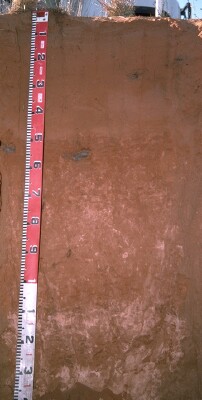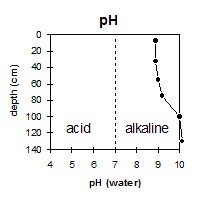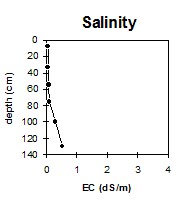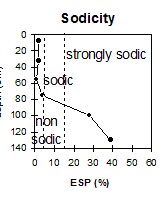MP20
| Australian Soil Classification: Endohypersodic, Regolithic, Hypercalcic CALCAROSOL | |
| Location: Pirlta | General Landscape Description: Crest of east-west dune. |
Soil Profile Morphology:
Surface Soil
| A11 | 0-15 cm | Reddish brown (5YR4/4); light sandy loam; hardsetting surface crust up to 1 cm thick; massive in structure; slightly calcareous; pH 8.9; sharp change to: |  MP20 profile |
| A12 | 15-50 cm | Dark reddish brown (5YR3/4); light fine sandy loam; massive in structure; slightly calcareous; pH 8.9; clear change to: | |
| Subsoil | |||
| B1 | 50-60 cm | Yellowish red (5YR4/6); fine sandy loam; massive in structure with hard capping; slightly calcareous; pH 9.0; gradual change to: | |
| B21k | 60-90 cm | Yellowish red (5YR4/6); fine sandy loam; weak coarse angular blocky structure; soft carbonate common (15%); pH 9.2; gradual change to: | |
| B22 | 90-110 cm | Yellowish red (5YR5/6); sandy loam; weak coarse angular blocky structure; contains a few (5%) soft carbonates; pH 10.0; gradual change to: | |
| B23k | 110-150 cm | Yellowish red (5YR5/6); fine sandy clay loam; weak structure; contains very many (>50%) soft carbonates; pH 10.1. | |
Key Profile Features:
- Hardsetting and sandy surface soil.
- High amounts of fine sand throughout the soil profile.
- Very strongly alkaline throughout.
|
Whole Profile
- The strongly alkaline profile suggests that some nutrients (e.g. manganese, zinc, iron, copper) may be poorly available to plants. Nutrient deficiencies can be assessed by plant tissue analysis. Plant species should be chosen in accordance with this pH level.
- The profile is very sandy throughout and at 50-90 cm (B21) the subsoil has a very high fine sand content (66%). Accordingly, the water holding capacity is very low throughout.
Surface (A) Horizon
- The surface soil has a very high fine sand content and is hardsetting when dry. When cultivated in a dry condition it will become ‘powdery’ and subsequent rainfall may result in surface sealing occurring. The levels of organic carbon measured at the pit site are quite low (this may or may not be representative of the whole paddock). Organic matter levels will decline if cropping takes place and can be improved by adopting practices such as residue retention, minimum tillage and utilising pasture rotations. Increased organic matter will both improve aggregation as well as assist in the low water holding capacity and low inherent fertility of this surface soil.
- The levels of total nitrogen measured at this pit site is quite low. However, this is best assessed by taking a bulked sample from across the paddock.
- The low wilting point values (ranging from 2.9 to 2.4) throughout the surface soil indicate that plants will be able to utilise light rains during dry periods, by taking water up immediately. However, due to this soils low water storage capacity, plants will suffer moisture stress unless further rains occur.
- Infiltration of water is likely to be high in the surface horizons and interestingly, the majority of roots are in the upper surface (0-15 cm).
- There would be very high evaporation from these surface horizons as they have very sandy textures and water would evaporate just as quickly as if the water was sitting on the upper surface.
Subsoil (B) Horizon
- The salinity rating becomes moderate at about 1 m depth. These levels of soluble salts are likely to restrict the growth of salt sensitive plant species (e.g. faba beans, linseed, chickpeas and lupins) especially those that are deep rooted.
- The subsoil has a moderate inherent fertility throughout the subsoil which is beneficial for plant growth.
- The subsoil becomes strongly sodic at 90 cm depth but the majority of root growth occurs above this area.
Comments:
- At time of soil sampling (October 1994) the site had not been cropped for 6 years, but grew good wheat crops before that time.





